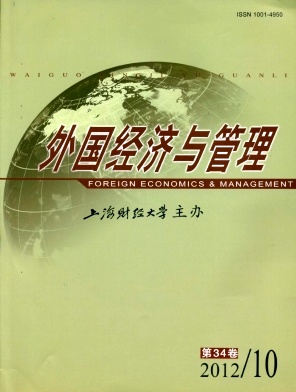供应商适应行为研究述评与展望
外国经济与管理 2012 年 第 34 卷第 10 期, 页码:13 - 21
摘要
参考文献
摘要
促使供应商做出适应行为是制造商提高运营绩效、获取竞争优势的重要途径。研究与供应商适应行为相关的问题,有助于制造商设计有效的供应商适应行为管理机制,构建有价值、高效率的双边关系。本文在系统梳理现有研究文献的基础上,阐述了供应商适应行为的内涵和外延,总结了供应商适应行为的特性,分析了供应商做出适应行为的动机,归纳了企业层面、关系层面、外部环境层面和适应行为层面影响供应商适应行为的因素,并探讨了供应商适应行为的影响效应,最后指出了未来研究方向。
关键词
①例如,供应商改变产品规格以满足制造商的需求(Schmidt等,2007)。
②例如,为了更好地与制造商的运营系统匹配,除了在产品方面做出适应行为外,供应商还在IT系统方面做出适应行为,如改变数据格式和软件界面(Schmidt等,2007)。
③这里仅论述了供应商做出适应行为的整个过程。
④例如,与欧美发达国家相比,“关系”(guanxi)对于我国企业间关系的建立和维持起到更加重要的作用(Yen等,2011)。
⑤参见Chang等人于2012年发表的论文《How buyer-sellerrelationship quality influences adaptation and innovation by for-eign MNCs’subsidiaries》。
⑥参见Lin于2004年发表的论文《Determinations of cultur-al adaptation in Chinese-U.S.joint ventures》。
⑦例如,Brennan和Turnbull(1999)通过访谈发现,供应商适应行为与制造商-供应商关系期(relationship age)无关。而关系期在供应链管理研究领域常被用作调节变量,如Yu等(2006)考察了制造商-供应商关系期对正式治理机制(自变量)与交易专用性投资(因变量)关系的调节作用。
⑧例如,Mukherji和Francis(2008)研究发现,供应商适应行为与供应商对制造商的信任负相关。这与先前的研究结论完全相反,因而有必要考虑其他因素的调节效应。
[1]Ahmad R and Buttle F.Customer retention:A potentially po-tent marketing management strategy[J].Journal of Strategic Marketing,2001,9(1):29-45.
[2]Braunscheidel M J and Suresh N C.The organizational ante-cedents of a firm’s supply chain agility for risk mitigation and response[J].Journal of Operations Management,2009,27(2):119-140.
[3]Brennan D R,et al.Dyadic adaptation in business-to-business markets[J].European Journal of Marketing,2003,37(11/12):1636-1665.
[4]Brennan R and Turnbull P W.Adaptive behavior in buyer-supplier relationships[J].Industrial Marketing Management,1999,28(5):481-495.
[5]Cai S,et al.Implementing supply chain information integration in China:The role of institutional forces and trust[J].Journal of Operations Management,2010,28(3):257-268.
[6]Canning L and Hanmer-Lloyd S.Modeling the adaptation process in interactive business relationships[J].Journal of Business&Industrial Marketing,2002,17(7):615-636.
[7]Fang T.Culture as a driving force for interfirm adaptation:A Chinese case[J].Industrial Marketing Management,2001,30(1):51-63.
[8]GaddeLE,et al.Interactiveresourcedevelopment in new busi-ness relationships[J].Journal of Business Research,2012,65(2):210-217.
[9]Gounaris S P,et al.Managing a firm’s behavior through mar-ket orientation development:Some empirical findings[J].Eu-ropean Journal of Marketing,2004,38(11/12):1481-1508.
[10]Griffith D,et al.Social exchange in supply chain relation-ships:The resulting benefits of procedural and distributive justice[J].Journal of Operations Management,2006,24(2):85-98.
[11]Hagberg-Andersson A.Does adaptation pay off?[J].Indus-trial Marketing Management,2006,35(2):202-209.
[12]Hkansson H.International marketing and purchasing of in-dustrial goods:An interaction approach[M].Chichester and New York:Wiley,1982.
[13]Hsieh Y,et al.Supplier market orientation and accommoda-tion of the customer in different relationship phases[J].In-dustrial Marketing Management,2008,37(4):380-393.
[14]Ireland R D and Webb J W.A multi-theoretic perspective on trust and power in strategic supply chains[J].Journal of Operations Management,2007,25(2):482-497.
[15]Knoppen D and Christiaanse E.Interorganizational adapta-tion in supply chains:A behavioral perspective[J].Interna-tional Journal of Logistics Management,2007,18(2):217-237.
[16]Knoppen D,et al.Supply chain relationships:Exploring the linkage between inter-organizational adaptation and learning[J].Journal of Purchasing and Supply Management,2010,16(3):195-205.
[17]Krause D R,et al.The relationships between supplier deve-lopment,commitment,social capital accumulation and per-formance improvement[J].Journal of Operations Manage-ment,2007,25(2):528-545.
[18]Lazzarini S G,et al.Dealing with the paradox of embedded-ness:The role of contracts and trust in facilitating movement out of committed relationships[J].Organization Science,2008,19(5):709-728.
[19]Liu Y,et al.Governing buyer-supplier relationships through transactional and relational mechanisms:Evidence from China[J].Journal of Operations Management,2009,27(4):294-309.
[20]Lockstrm M,et al.Antecedents to supplier integration in the automotive industry:A multiple-case study of foreign subsidiaries in China[J].Journal of Operations Management,2010,28(3):240-256.
[21]McEvily B and Marcus A.Embedded ties and the acquisition of competitive capabilities[J].Strategic Management Jour-nal,2005,26(11):1033-1055.
[22]Mukherji A and Francis J.Mutual adaptation in buyer-sup-plier relationships[J].Journal of Business Research,2008,61(2):154-161.
[23]Paulraj A,et al.Inter-organizational communication as a rela-tional competency:Antecedents and performance outcomes in collaborative buyer-supplier relationships[J].Journal of Op-erations Management,2008,26(1):45-64.
[24]Prahinski C and Benton W C.Supplier evaluations:Commu-nication strategies to improve supplier performance[J].Jour-nal of Operations Management,2004,22(1):39-62.
[25]Schmidt S O,et al.Adaptation in inter-firm relationships:Classification,motivation,calculation[J].Journal of Services Marketing,2007,21(7):530-537.
[26]Terawatanavong C,et al.Technological turbulence,supplier market orientation,and buyer satisfaction[J].Journal of Bus-iness Research,2011,64(8):911-918.
[27]Wilkinson I F and Young L C.Business dancing—The nature and role of interfirm relations in business strategy[J].Asia-Australia Marketing Journal,1994,2(1):67-79.
[28]Wong C Y,et al.The contingency effects of environmental uncertainty on the relationship between supply chain integra-tion and operational performance[J].Journal of Operations Management,2011,29(6):604-615.
[29]Yen D A,et al.The measurement of guanxi:Introducing the GRX scale[J].Industrial Marketing Management,2011,40(1):97-108.
[30]Yu C,et al.Formal governance mechanisms,relational go-vernance mechanisms,and transaction-specific investments in supplier-manufacturer relationships[J].Industrial Marketing Management,2006,35(2):128-139.
②例如,为了更好地与制造商的运营系统匹配,除了在产品方面做出适应行为外,供应商还在IT系统方面做出适应行为,如改变数据格式和软件界面(Schmidt等,2007)。
③这里仅论述了供应商做出适应行为的整个过程。
④例如,与欧美发达国家相比,“关系”(guanxi)对于我国企业间关系的建立和维持起到更加重要的作用(Yen等,2011)。
⑤参见Chang等人于2012年发表的论文《How buyer-sellerrelationship quality influences adaptation and innovation by for-eign MNCs’subsidiaries》。
⑥参见Lin于2004年发表的论文《Determinations of cultur-al adaptation in Chinese-U.S.joint ventures》。
⑦例如,Brennan和Turnbull(1999)通过访谈发现,供应商适应行为与制造商-供应商关系期(relationship age)无关。而关系期在供应链管理研究领域常被用作调节变量,如Yu等(2006)考察了制造商-供应商关系期对正式治理机制(自变量)与交易专用性投资(因变量)关系的调节作用。
⑧例如,Mukherji和Francis(2008)研究发现,供应商适应行为与供应商对制造商的信任负相关。这与先前的研究结论完全相反,因而有必要考虑其他因素的调节效应。
[1]Ahmad R and Buttle F.Customer retention:A potentially po-tent marketing management strategy[J].Journal of Strategic Marketing,2001,9(1):29-45.
[2]Braunscheidel M J and Suresh N C.The organizational ante-cedents of a firm’s supply chain agility for risk mitigation and response[J].Journal of Operations Management,2009,27(2):119-140.
[3]Brennan D R,et al.Dyadic adaptation in business-to-business markets[J].European Journal of Marketing,2003,37(11/12):1636-1665.
[4]Brennan R and Turnbull P W.Adaptive behavior in buyer-supplier relationships[J].Industrial Marketing Management,1999,28(5):481-495.
[5]Cai S,et al.Implementing supply chain information integration in China:The role of institutional forces and trust[J].Journal of Operations Management,2010,28(3):257-268.
[6]Canning L and Hanmer-Lloyd S.Modeling the adaptation process in interactive business relationships[J].Journal of Business&Industrial Marketing,2002,17(7):615-636.
[7]Fang T.Culture as a driving force for interfirm adaptation:A Chinese case[J].Industrial Marketing Management,2001,30(1):51-63.
[8]GaddeLE,et al.Interactiveresourcedevelopment in new busi-ness relationships[J].Journal of Business Research,2012,65(2):210-217.
[9]Gounaris S P,et al.Managing a firm’s behavior through mar-ket orientation development:Some empirical findings[J].Eu-ropean Journal of Marketing,2004,38(11/12):1481-1508.
[10]Griffith D,et al.Social exchange in supply chain relation-ships:The resulting benefits of procedural and distributive justice[J].Journal of Operations Management,2006,24(2):85-98.
[11]Hagberg-Andersson A.Does adaptation pay off?[J].Indus-trial Marketing Management,2006,35(2):202-209.
[12]Hkansson H.International marketing and purchasing of in-dustrial goods:An interaction approach[M].Chichester and New York:Wiley,1982.
[13]Hsieh Y,et al.Supplier market orientation and accommoda-tion of the customer in different relationship phases[J].In-dustrial Marketing Management,2008,37(4):380-393.
[14]Ireland R D and Webb J W.A multi-theoretic perspective on trust and power in strategic supply chains[J].Journal of Operations Management,2007,25(2):482-497.
[15]Knoppen D and Christiaanse E.Interorganizational adapta-tion in supply chains:A behavioral perspective[J].Interna-tional Journal of Logistics Management,2007,18(2):217-237.
[16]Knoppen D,et al.Supply chain relationships:Exploring the linkage between inter-organizational adaptation and learning[J].Journal of Purchasing and Supply Management,2010,16(3):195-205.
[17]Krause D R,et al.The relationships between supplier deve-lopment,commitment,social capital accumulation and per-formance improvement[J].Journal of Operations Manage-ment,2007,25(2):528-545.
[18]Lazzarini S G,et al.Dealing with the paradox of embedded-ness:The role of contracts and trust in facilitating movement out of committed relationships[J].Organization Science,2008,19(5):709-728.
[19]Liu Y,et al.Governing buyer-supplier relationships through transactional and relational mechanisms:Evidence from China[J].Journal of Operations Management,2009,27(4):294-309.
[20]Lockstrm M,et al.Antecedents to supplier integration in the automotive industry:A multiple-case study of foreign subsidiaries in China[J].Journal of Operations Management,2010,28(3):240-256.
[21]McEvily B and Marcus A.Embedded ties and the acquisition of competitive capabilities[J].Strategic Management Jour-nal,2005,26(11):1033-1055.
[22]Mukherji A and Francis J.Mutual adaptation in buyer-sup-plier relationships[J].Journal of Business Research,2008,61(2):154-161.
[23]Paulraj A,et al.Inter-organizational communication as a rela-tional competency:Antecedents and performance outcomes in collaborative buyer-supplier relationships[J].Journal of Op-erations Management,2008,26(1):45-64.
[24]Prahinski C and Benton W C.Supplier evaluations:Commu-nication strategies to improve supplier performance[J].Jour-nal of Operations Management,2004,22(1):39-62.
[25]Schmidt S O,et al.Adaptation in inter-firm relationships:Classification,motivation,calculation[J].Journal of Services Marketing,2007,21(7):530-537.
[26]Terawatanavong C,et al.Technological turbulence,supplier market orientation,and buyer satisfaction[J].Journal of Bus-iness Research,2011,64(8):911-918.
[27]Wilkinson I F and Young L C.Business dancing—The nature and role of interfirm relations in business strategy[J].Asia-Australia Marketing Journal,1994,2(1):67-79.
[28]Wong C Y,et al.The contingency effects of environmental uncertainty on the relationship between supply chain integra-tion and operational performance[J].Journal of Operations Management,2011,29(6):604-615.
[29]Yen D A,et al.The measurement of guanxi:Introducing the GRX scale[J].Industrial Marketing Management,2011,40(1):97-108.
[30]Yu C,et al.Formal governance mechanisms,relational go-vernance mechanisms,and transaction-specific investments in supplier-manufacturer relationships[J].Industrial Marketing Management,2006,35(2):128-139.
引用本文
张延涛, 李随成, 杨婷. 供应商适应行为研究述评与展望[J]. 外国经济与管理, 2012, 34(10): 13–21.
导出参考文献,格式为:





 6045
6045  337
337

